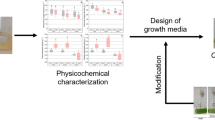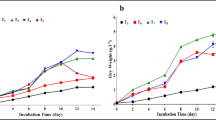Abstract
The treatment and utilization of cheese whey (W) represents one of the major challenges facing the dairy industry. In this work the production of Chlorella vulgaris and its potential use in recovering the main nutrients (N, P and C) from cheese whey was evaluated in batch and continuous mode. Four different treatments were evaluated: Fertilizers-control (100% freshwater plus chemical fertilizers); Fertilizers-2.5%W (v/v), Fertilizers-5%W (v/v) and Fertilizers-10%W (v/v). The biomass productivity was affected by the percentage of cheese whey added, resulting in a 2.8-fold increase when adding 10% cheese whey to the culture medium. In addition, the cheese whey concentration in the culture medium also affected the overall macromolecular composition of the biomass along with the appearance and growth of aerobic mesophilic bacteria. Despite the high concentration of organic matter in the cheese whey (COD, 60.000 mg L-1), C. vulgaris was able to recover more than 80% of COD in continuous mode, along with 94 % and 60% of TN and TP, respectively. These promising results can be explained by the mixotrophic activity of C. vulgaris, which was demonstrated by the decrease in the chlorophyll content when cheese whey was added to the culture medium and by photo-respirometric assays. The use of cheese whey for microalgal biomass production represents a sustainable alternative to revaluate this by-product stream and contribute to the circular economy.





Similar content being viewed by others
Data availability
The datasets generated during the current study are available from the corresponding author on reasonable request.
References
Abreu AP, Fernandes B, Vicente AA, Teixeira J, Dragone G (2012) Mixotrophic cultivation of Chlorella vulgaris using industrial dairy waste as organic carbon source. Bioresour Technol 118:61–66
Acién FG, Molina E, Reis A, Torzillo G, Zittelli GC, Sepúlveda C, Masojídek J (2017) 1 - Photobioreactors for the production of microalgae. In: Gonzalez-Fernandez C, Muñoz R (eds) Microalgae-Based Biofuels and Bioproducts. Woodhead Publishing, Duxford, pp 1–44
Amado IR, Vázquez JA, Pastrana L, Teixeira JA (2016) Cheese whey: A cost-effective alternative for hyaluronic acid production by Streptococcus zooepidemicus. Food Chem 198:54–61
Asunis F, De Gioannis G, Dessì P, Isipato M, Lens PNL, Muntoni A, Polettini A, Pomi R, Rossi A, Spiga D (2020) The dairy biorefinery: Integrating treatment processes for cheese whey valorisation. J Environ Manage 276:111240
B Pereira MI, E Chagas ID BM, Sassi R, Medeiros GF, Aguiar EM, F Borba LH, E Silva EP, lio Andrade Neto JC, N Rangel AH (2019) Mixotrophic cultivation of Spirulina platensis in dairy wastewater: Effects on the production of biomass, biochemical composition and antioxidant capacity. PLoS One 14:e0224294
Chatzipaschali AA, Stamatis AG (2012) Biotechnological utilization with a focus on anaerobic treatment of cheese whey: Current status and prospects. Energies 5:3492–3525
D’Imporzano G, Veronesi D, Salati S, Adani F (2018) Carbon and nutrient recovery in the cultivation of Chlorella vulgaris: A life cycle assessment approach to comparing environmental performance. J Clean Prod 194:685–694
de Carvalho Silvello MA, Severo Gonçalves I, Patrícia Held Azambuja S, Silva Costa S, Garcia Pereira Silva P, Oliveira Santos L, Goldbeck R (2022) Microalgae-based carbohydrates: A green innovative source of bioenergy. Bioresour Technol 344:126304
Espinosa-Gonzalez I, Parashar A, Bressler DC (2014) Heterotrophic growth and lipid accumulation of Chlorella protothecoides in whey permeate, a dairy by-product stream, for biofuel production. Bioresour Technol 155:170–176
FAO (2019) The State of Food and Agriculture 2019. Moving forward on food loss and waste reduction. Food and Agriculture Organisation, Rome.
FAO (2011) Global Food Losses and Food Waste – Extent, Causes and Prevention. Food and Agriculture Organisation, Rome
Fuentes JL, Garbayo I, Cuaresma M, Montero Z, González-Del-Valle M, Vílchez C (2016) Impact of microalgae-bacteria interactions on the production of algal biomass and associated compounds. Mar Drugs 14:100
García-Márquez J, Rico RM, del Sánchez-Saavedra M, P, Gómez-Pinchetti JL, Acién FG, Figueroa FL, Alarcón FJ, Moriñigo MÁ, Abdala-Díaz RT, (2020) A short pulse of dietary algae boosts immune response and modulates fatty acid composition in juvenile Oreochromis niloticus. Aquac Res 51:4397–4409
Girard JM, Roy ML, Ben Hafsa M, Gagnon J, Faucheux N, Heitz M, Tremblay R, Deschênes JS (2014) Mixotrophic cultivation of green microalgae Scenedesmus obliquus on cheese whey permeate for biodiesel production. Algal Res 5:241–248
Grama BS, Agathos SN, Jeffryes CS (2016) Balancing photosynthesis and respiration increases microalgal biomass productivity during photoheterotrophy on glycerol. ACS Sustain Chem Eng 4:1611–1618
Grobbelaar JU, Soeder CJ (1985) Respiration losses in planktonic green algae cultivated in raceway ponds. J Plankton Res 7:497–506
Gutiérrez-Hernández CA, Hernández-Almanza A, Hernández-Beltran JU, Balagurusamy N, Hernández-Teran F (2022) Cheese whey valorization to obtain single-cell oils of industrial interest: An overview. Food Biosci 50:102086
Han T, Han X, Ye X, Xi Y, Zhang Y, Guan H (2022) Applying mixotrophy strategy to enhance biomass production and nutrient recovery of Chlorella pyrenoidosa from biogas slurry: An assessment of the mixotrophic synergistic effect. Bioresour Technol 366:128185
Hashemian M, Ahmadzadeh H, Hosseini M, Lyon S, Pourianfar HR (2019) Production of microalgae-derived high-protein biomass to enhance food for animal feedstock and human consumption. In: Hosseini M (ed) Advanced Bioprocessing for Alternative Fuels, Biobased Chemicals, and Bioproducts. Woodhead Publishing, Duxford, pp 393–405
Ippoliti D, Gómez C, del Mar Morales-Amaral M, Pistocchi R, Fernández-Sevilla JM, Acién FG (2016) Modeling of photosynthesis and respiration rate for Isochrysis galbana (T-Iso) and its influence on the production of this strain. Bioresour Technol 203:71–79
Lavelli V, Beccalli MP (2022) Cheese whey recycling in the perspective of the circular economy: Modeling processes and the supply chain to design the involvement of the small and medium enterprises. Trends Food Sci Technol 126:86–98
Loftus SE, Johnson ZI (2019) Reused cultivation water accumulates dissolved organic carbon and uniquely influences different marine microalgae. Front Bioeng Biotechnol 7:444452
López CVG, del Carmen Cerón García M, Fernández FGA, Bustos CS, Chisti Y, Sevilla JMF, (2010) Protein measurements of microalgal and cyanobacterial biomass. Bioresour Technol 101:7587–7591
Lu Z, Loftus S, Sha J, Wang W, Park MS, Zhang X, Johnson ZI, Hu Q (2020) Water reuse for sustainable microalgae cultivation: Current knowledge and future directions. Resour Conserv Recycl 161:104975
Maadane A, Merghoub N, Ainane T, El Arroussi H, Benhima R, Amzazi S, Bakri Y, Wahby I (2015) Antioxidant activity of some Moroccan marine microalgae: Pufa profiles, carotenoids and phenolic content. J Biotechnol 215:13–19
Malapascua JRF, Jerez CG, Sergejevová M, Figueroa FL, Masojídek J (2014) Photosynthesis monitoring to optimize growth of microalgal mass cultures: application of chlorophyll fluorescence techniques. Aquat Biol 22:123–140
ntikci M, Hansen JLS, Markager S, (2017) Photosynthesis enhanced dark respiration in three marine phytoplankton species. J Exp Mar Biol Ecol 497:188–196
Marazzi F, Bellucci M, Fantasia T, Ficara E, Mezzanotte V (2020) Interactions between microalgae and bacteria in the treatment of wastewater from milk whey processing. Water 12:297
Marcone RD, Schmid M, Meylan G (2022) Closing the gap between EU-wide national bioeconomy monitoring frameworks and urban circular bioeconomy development. J Clean Prod 379:134563
Morillas-España A, Sánchez-Zurano A, Gómez-Serrano C, Ciardi M, Acién G, Clagnan E, Adani F, Lafarga T (2021) Potential of the cyanobacteria Anabaena sp. and Dolichospermum sp. for being produced using wastewater or pig slurry: Validation using pilot-scale raceway reactors. Algal Res 60:102517 .
Nagarajan D, Lee DJ, Chen CY, Chang JS (2020) Resource recovery from wastewaters using microalgae-based approaches: A circular bioeconomy perspective. Bioresour Technol 302:122817
Perera E, Sánchez-Ruiz D, Sáez MI, Galafat A, Barany A, Fernández-Castro M, Vizcaíno AJ, Fuentes J, Martínez TF, Mancera JM, Alarcón FJ, Martos-Sitcha JA (2020) Low dietary inclusion of nutraceuticals from microalgae improves feed efficiency and modifies intermediary metabolisms in gilthead sea bream (Sparus aurata). Sci Rep 10:18676
Ribeiro JES, Martini M, Altomonte I, Salari F, Nardoni S, Sorce C, da Silva FLH, Andreucci A (2017) Production of Chlorella protothecoides biomass, chlorophyll and carotenoids using the dairy industry by-product scotta as a substrate. Biocatal Agric Biotechnol 11:207–213
Rossi S, Bellucci M, Marazzi F, Mezzanotte V, Ficara E (2018) Activity assessment of microalgal-bacterial consortia based on respirometric tests. Water Sci Technol 78:207–215
Salati S, D’Imporzano G, Menin B, Veronesi D, Scaglia B, Abbruscato P, Mariani P, Adani F (2017) Mixotrophic cultivation of Chlorella for local protein production using agro-food by-products. Bioresour Technol 230:82–89
Sánchez-Zurano A, Gómez-Serrano C, Acién-Fernández FG, Fernández-Sevilla JM, Molina-Grima E (2020) A novel photo-respirometry method to characterize consortia in microalgae-related wastewater treatment processes. Algal Res 47:101858
Sánchez Zurano A, Gómez Serrano C, Acién-Fernández FG, Fernández-Sevilla JM, Molina-Grima E (2021) Modeling of photosynthesis and respiration rate for microalgae–bacteria consortia. Biotechnol Bioeng 118:952–962
Sforza E, Pastore M, Barbera E, Bertucco A (2019) Respirometry as a tool to quantify kinetic parameters of microalgal mixotrophic growth. Bioprocess Biosyst Eng 42:839–851
Shimakawa G, Kohara A, Miyake C (2021) Characterization of light-enhanced respiration in cyanobacteria. Int J Mol Sci 22:342
Acknowledgements
The authors would like to thank José Escánez for his technical assistance.
Funding
This research forms part of the ALGA4FF Project funded by the Regional Government of Andalusia (P20_00812) and by the H2020 Research and Innovation Framework Programme (project: PRODIGIO, 101007006). This study was also supported by the Campus of International Excellence of the Sea (CEIMAR) through the Young Research Project Program 2022 (project: ALGABIOTIC) and by Ministerio de Ciencia e Innovación (grant TED2021-131555B-C21 ALGAHUB). A. Sánchez-Zurano would like to thank the University of Almeria (Contract Puente, UAL Program 2022), T. Lafarga, and the Ramon y Cajal Programme (RYC2021-031061-I).
Author information
Authors and Affiliations
Contributions
A.S, S.V and M.C carried out the research, formal analysis and data curation. A.S wrote the main manuscript text and prepared the figures. J.M and F.G obtained the funding and supervised the study. T.L supervised the study and reviewed the manuscript.
Corresponding author
Ethics declarations
Competing interests
The authors have no competing interests to declare that are relevant to the content of this article.
Additional information
Publisher's Note
Springer Nature remains neutral with regard to jurisdictional claims in published maps and institutional affiliations.
Rights and permissions
Springer Nature or its licensor (e.g. a society or other partner) holds exclusive rights to this article under a publishing agreement with the author(s) or other rightsholder(s); author self-archiving of the accepted manuscript version of this article is solely governed by the terms of such publishing agreement and applicable law.
About this article
Cite this article
Sánchez-Zurano, A., Villaró-Cos, S., Ciardi, M. et al. Assessment of the mixotrophic production of Chlorella vulgaris using milk whey as a nutrient source. J Appl Phycol 36, 87–100 (2024). https://doi.org/10.1007/s10811-023-03142-5
Received:
Revised:
Accepted:
Published:
Issue Date:
DOI: https://doi.org/10.1007/s10811-023-03142-5




